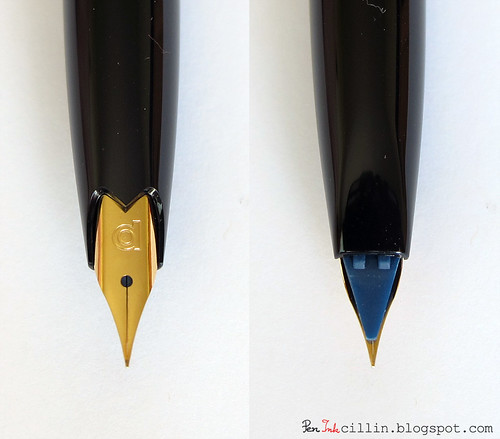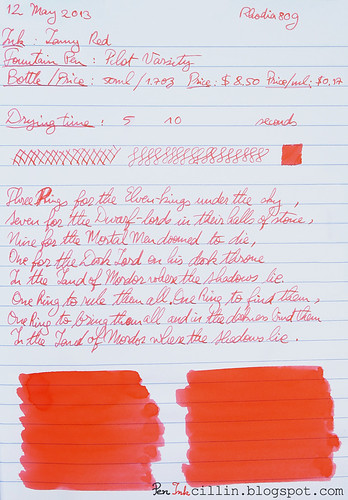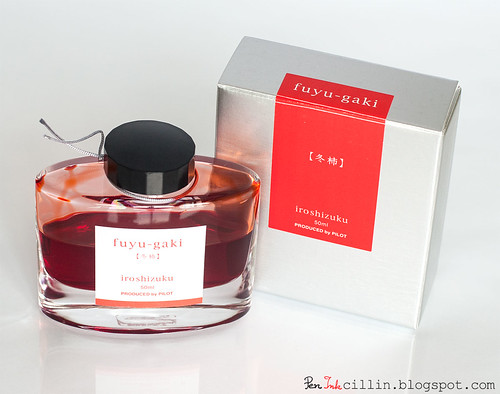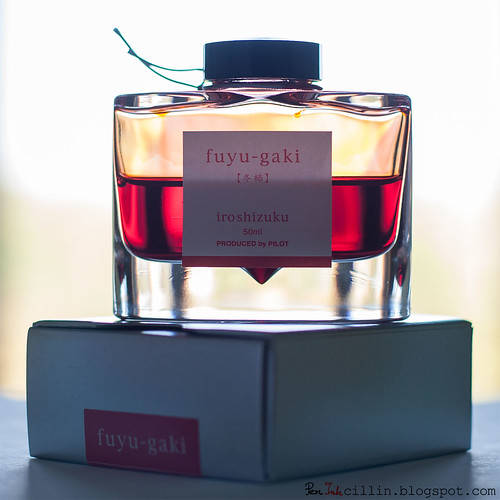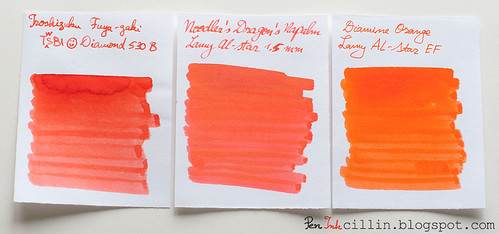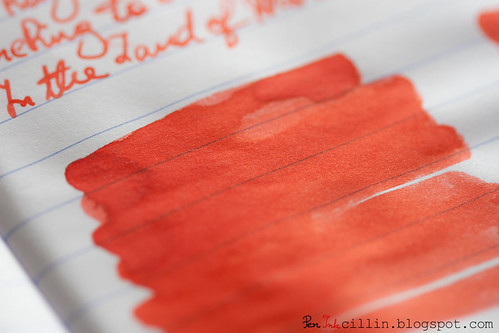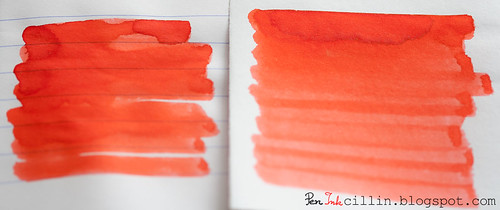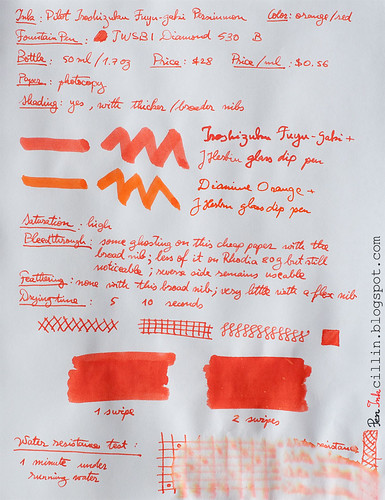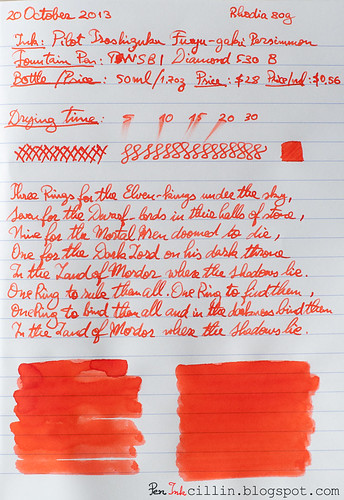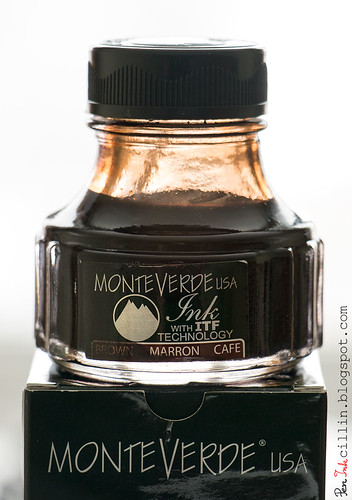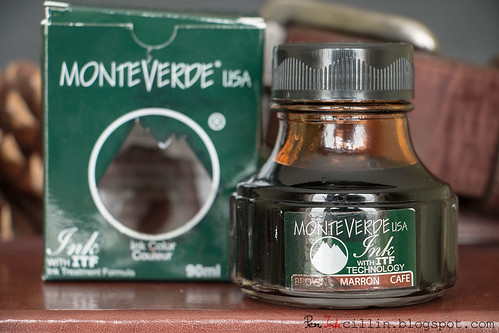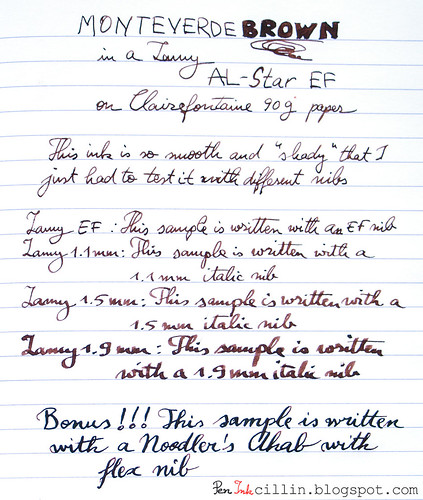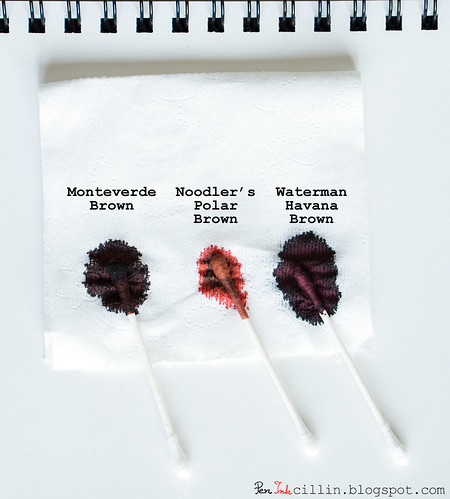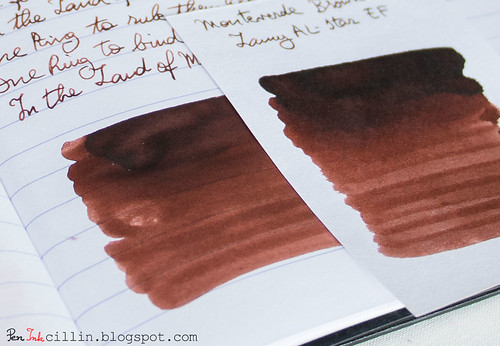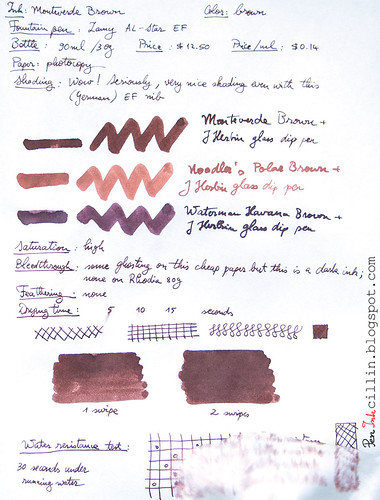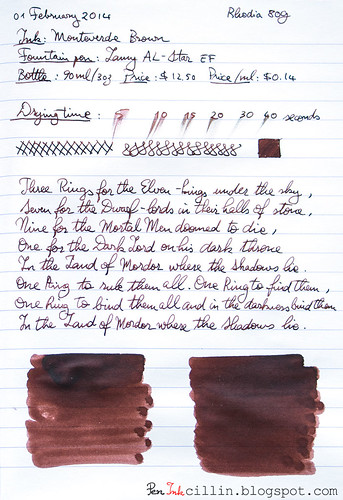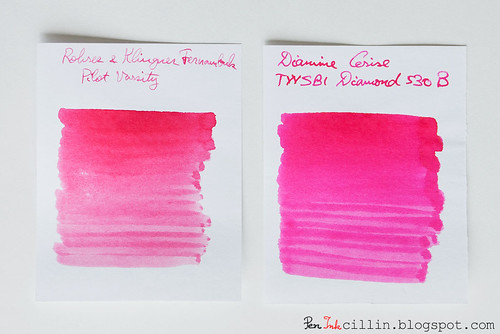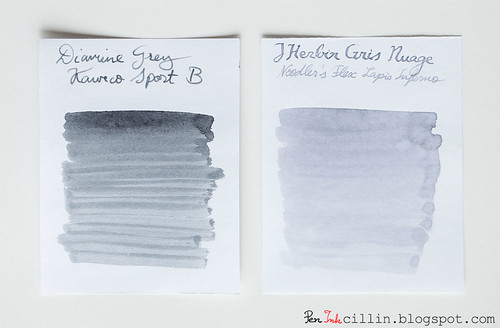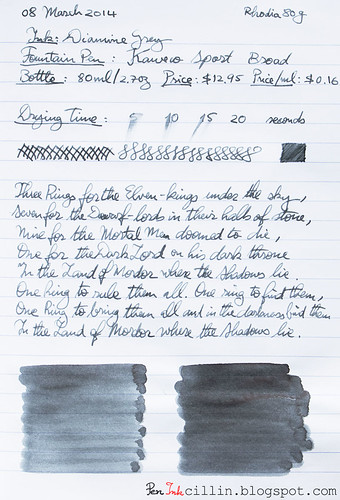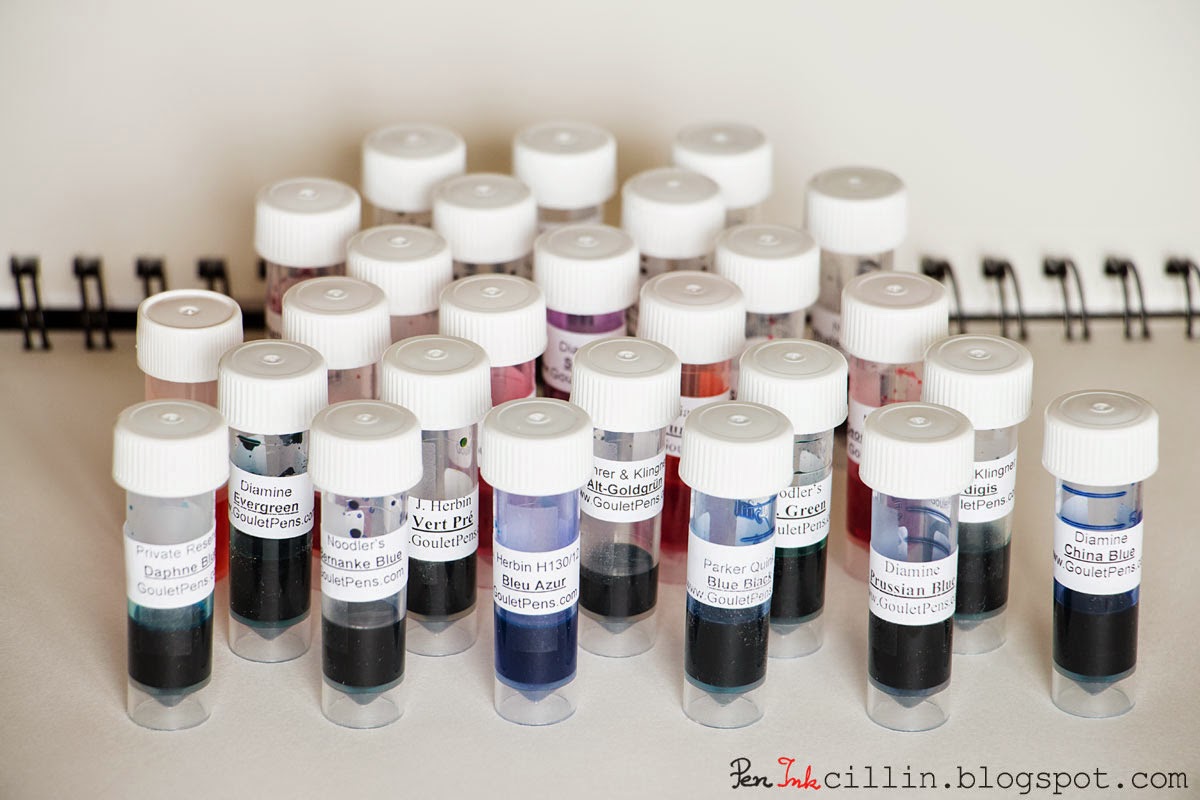I decided that 2012 would be the year when I stopped buying fountain pens, concentrating instead on reviewing the many ink samples that I have accumulated. Jetpens decided to spoil my resolution by sending me a fountain pen for review. I'm not one to refuse such an occasion so here I am, reviewing my first fountain pen this year: the Platinum Carbon Desk.
I don't have a lot of experience with Platinum pens, the only other that I have tried being the cheap (and almost-disposable) Platinum Preppy. The Platinum Carbon costs a lot more than the Preppy ($13.50) but it also seems to serve a different and more specialized function. From what I gather, the "Desk" designation suggests that it is a good companion for a... um... desk. In fact, Jetpens also sells a stand for the Carbon pen which replaces the cap if you choose to use it instead. The stand is also more expensive than the pen itself but that shouldn't be an objection if you want to make your desk look classy.
At $13.50 don't expect fancy packaging and the Carbon doesn't break the norm. It comes in a simple plastic sleeve, together with a black ink cartridge. There are instructions written in Japanese all over the packaging but I threw it away nonetheless.
In my view, the Platinum Carbon looks like one of those old pens that I would expect to see on my grandfather's desk and it is very reminiscent of a dip pen. The black plastic body is long and sleek, tapering down to an almost sharp point. This, of course, completely negates any desire to post the cap. For me that's not a biggie because in general I don't like to post caps anyway.
The Platinum logo and "Carbon Pen" are embossed in gold on the barrel and there's gold trim where the cap stops.
Speaking of the cap, it is friction-fit and quite plain. It tapers slightly at the top and has a thick hexagonal rim which undoubtedly is meant to prevent the pen from rolling across your desk, since it doesn't have a clip. Interestingly, the included ink cartridge also has the logo and "Carbon Ink" embossed, only this time in silver.
Removing the cap reveals a "gold-plated" nib which reminds me a lot of those classic hooded nibs, even though it isn't one, though it is narrow and thin enough to give the impression. The fact that it's gold plated plays in tune with the other gold trim found on the pen but frankly it leaves me indifferent. I doubt gold plating has any effect over the way it writes, as opposed to an actual gold nib. And I'm not saying that I was expecting a real gold nib for $13, goodness no. Personally I prefer silver (iridium) nibs and trim but that's just me.
A close-up of the nib shows how thin it is. Apparently this is an XF nib which is exciting for me because I've never tried a true Japanese XF. Of course, I have my Lamy AL-Star EF but, being European, it compares more favorably to a Japanese M/B. The underside shows the odd-looking plastic feed which for some reason is blue.
Unscrewing the barrel reveals the metal threads and this fact alone immediately dashes any hopes that this pen could be converted to an eyedropper. Well, this and the fact that the thin end of the barrel isn't sealed. But that's alright, I don't see any reason why someone would need the extra capacity for such a thin nib. As it is, the ink cartridge is hefty enough.
Just for fun, I decided to compare the Platinum Carbon pen to my other thin-nibbed Japanese pen: the Sailor HighAce Neo which features an F nib. I thought that the Sailor was thin as a needle, but when you put the two side by side, it looks as thick as a tree trunk compared to the Carbon. Now you can truly see how sharp and precise the Platinum Carbon's nib is. This is the point where I got scared because I didn't know if I was capable of using such a thin nib. I'm only partially kidding...
Moving on to the writing experience, I produced this sample (written on Clairefontaine 90g paper). Please excuse my poor attempts at doodling but I thought such an exercise would be perfect for the XF nib.
Before discussing the actual writing experience, let me talk a little bit about the ink itself. The included cartridge holds no ordinary ink. This is Platinum's Carbon ink which is waterproof and also resistant to forgery. As far as I know, there aren't many inks like that which come in a cartridge. To boot, it is also pigment-based, which apparently makes it more suitable for this type of pen.
After plugging in the cartridge it didn't take long for the ink to flow. It took me a couple of minutes to prime it but after that the pen wrote very smoothly. The flow is good but because the nib is so thin, it feels just a tiny bit grippy on the side-to-side strokes. It doesn't surprise me, because it's like writing with a sewing needle.
Did I mention the nib is sharp and precise? I'm not sure I did, but to reiterate, it is definitely the most precise nib I've laid hands on. It's amazing what detail you can draw, provided you have steady hands. I'm not used to such precise nibs and my handwriting tends to become spidery.
Comparing the Platinum Carbon to the Sailor HighAce Neo, I've come to realize that there's quite a difference between them. Before the Carbon, I thought the Sailor's nib was sharp. Boy was I wrong. Even though it might not be entirely obvious from the sample (look closely at the spiral), the Sailor feels a lot thicker and less precise.
Going back to the ink, I used Noodler's Heart of Darkness in the HighAce Neo. As you can see, there's virtually no difference between the two inks. Since HoD is already a very dark ink, we can infer that Platinum Carbon is also very dark. Personally I like deep blacks. The interesting thing, though, is that Heart of Darkness feathered on the Clairefontaine paper. I was very surprised by this because normally it is a very well behaved ink, but there you have it. Platinum Carbon, on the other hand, didn't.
I also ran a basic water resistance test, once again comparing the two inks. It turns out that Platinum Carbon beats Noodler's Heart of Darkness in this aspect. I placed a drop of water inside each grid and waited for it to dry. The Platinum sample looks virtually untouched. The HoD sample shows a little shadow where the drop evaporated. This means some of the water washed off and makes Platinum Carbon the winner in this informal contest.
I should mention one last thing which almost slipped my mind. The Platinum Carbon is a very light pen but it is comfortable to hold. The balance is optimal for me thanks to the long barrel. I didn't feel any fatigue while creating the sample.
Conclusion
To wrap this up, Platinum Carbon surprised me in a number of different ways. While the design of the pen is nothing to write home about (though it would look classy on a business person's desk), and personally I'm not very partial to the gold trim, the real beauty lies in the nib. This incredibly precise needle seems to be perfectly suited for drawing very fine details, especially when paired with the Carbon waterproof ink. For example you can use it to trace a drawing and then paint it with watercolor without fear.
Myself, I'm not a big fan of fine nibs. I thought I was, that's why I bought the Sailor HighAce Neo, but then I realized that I prefer broader strokes, where the ink can show its full potential. But that's just me. If you have a preference for fine nibs, I'm sure the Platinum Carbon has one of the finest you will find, and all that for a pittance.
Finally, thanks again to David at Jetpens for providing this opportunity!
I don't have a lot of experience with Platinum pens, the only other that I have tried being the cheap (and almost-disposable) Platinum Preppy. The Platinum Carbon costs a lot more than the Preppy ($13.50) but it also seems to serve a different and more specialized function. From what I gather, the "Desk" designation suggests that it is a good companion for a... um... desk. In fact, Jetpens also sells a stand for the Carbon pen which replaces the cap if you choose to use it instead. The stand is also more expensive than the pen itself but that shouldn't be an objection if you want to make your desk look classy.
At $13.50 don't expect fancy packaging and the Carbon doesn't break the norm. It comes in a simple plastic sleeve, together with a black ink cartridge. There are instructions written in Japanese all over the packaging but I threw it away nonetheless.
In my view, the Platinum Carbon looks like one of those old pens that I would expect to see on my grandfather's desk and it is very reminiscent of a dip pen. The black plastic body is long and sleek, tapering down to an almost sharp point. This, of course, completely negates any desire to post the cap. For me that's not a biggie because in general I don't like to post caps anyway.
The Platinum logo and "Carbon Pen" are embossed in gold on the barrel and there's gold trim where the cap stops.
Speaking of the cap, it is friction-fit and quite plain. It tapers slightly at the top and has a thick hexagonal rim which undoubtedly is meant to prevent the pen from rolling across your desk, since it doesn't have a clip. Interestingly, the included ink cartridge also has the logo and "Carbon Ink" embossed, only this time in silver.
Removing the cap reveals a "gold-plated" nib which reminds me a lot of those classic hooded nibs, even though it isn't one, though it is narrow and thin enough to give the impression. The fact that it's gold plated plays in tune with the other gold trim found on the pen but frankly it leaves me indifferent. I doubt gold plating has any effect over the way it writes, as opposed to an actual gold nib. And I'm not saying that I was expecting a real gold nib for $13, goodness no. Personally I prefer silver (iridium) nibs and trim but that's just me.
A close-up of the nib shows how thin it is. Apparently this is an XF nib which is exciting for me because I've never tried a true Japanese XF. Of course, I have my Lamy AL-Star EF but, being European, it compares more favorably to a Japanese M/B. The underside shows the odd-looking plastic feed which for some reason is blue.
Unscrewing the barrel reveals the metal threads and this fact alone immediately dashes any hopes that this pen could be converted to an eyedropper. Well, this and the fact that the thin end of the barrel isn't sealed. But that's alright, I don't see any reason why someone would need the extra capacity for such a thin nib. As it is, the ink cartridge is hefty enough.
Just for fun, I decided to compare the Platinum Carbon pen to my other thin-nibbed Japanese pen: the Sailor HighAce Neo which features an F nib. I thought that the Sailor was thin as a needle, but when you put the two side by side, it looks as thick as a tree trunk compared to the Carbon. Now you can truly see how sharp and precise the Platinum Carbon's nib is. This is the point where I got scared because I didn't know if I was capable of using such a thin nib. I'm only partially kidding...
Moving on to the writing experience, I produced this sample (written on Clairefontaine 90g paper). Please excuse my poor attempts at doodling but I thought such an exercise would be perfect for the XF nib.
Before discussing the actual writing experience, let me talk a little bit about the ink itself. The included cartridge holds no ordinary ink. This is Platinum's Carbon ink which is waterproof and also resistant to forgery. As far as I know, there aren't many inks like that which come in a cartridge. To boot, it is also pigment-based, which apparently makes it more suitable for this type of pen.
After plugging in the cartridge it didn't take long for the ink to flow. It took me a couple of minutes to prime it but after that the pen wrote very smoothly. The flow is good but because the nib is so thin, it feels just a tiny bit grippy on the side-to-side strokes. It doesn't surprise me, because it's like writing with a sewing needle.
Did I mention the nib is sharp and precise? I'm not sure I did, but to reiterate, it is definitely the most precise nib I've laid hands on. It's amazing what detail you can draw, provided you have steady hands. I'm not used to such precise nibs and my handwriting tends to become spidery.
Comparing the Platinum Carbon to the Sailor HighAce Neo, I've come to realize that there's quite a difference between them. Before the Carbon, I thought the Sailor's nib was sharp. Boy was I wrong. Even though it might not be entirely obvious from the sample (look closely at the spiral), the Sailor feels a lot thicker and less precise.
Going back to the ink, I used Noodler's Heart of Darkness in the HighAce Neo. As you can see, there's virtually no difference between the two inks. Since HoD is already a very dark ink, we can infer that Platinum Carbon is also very dark. Personally I like deep blacks. The interesting thing, though, is that Heart of Darkness feathered on the Clairefontaine paper. I was very surprised by this because normally it is a very well behaved ink, but there you have it. Platinum Carbon, on the other hand, didn't.
I also ran a basic water resistance test, once again comparing the two inks. It turns out that Platinum Carbon beats Noodler's Heart of Darkness in this aspect. I placed a drop of water inside each grid and waited for it to dry. The Platinum sample looks virtually untouched. The HoD sample shows a little shadow where the drop evaporated. This means some of the water washed off and makes Platinum Carbon the winner in this informal contest.
I should mention one last thing which almost slipped my mind. The Platinum Carbon is a very light pen but it is comfortable to hold. The balance is optimal for me thanks to the long barrel. I didn't feel any fatigue while creating the sample.
Conclusion
To wrap this up, Platinum Carbon surprised me in a number of different ways. While the design of the pen is nothing to write home about (though it would look classy on a business person's desk), and personally I'm not very partial to the gold trim, the real beauty lies in the nib. This incredibly precise needle seems to be perfectly suited for drawing very fine details, especially when paired with the Carbon waterproof ink. For example you can use it to trace a drawing and then paint it with watercolor without fear.
Myself, I'm not a big fan of fine nibs. I thought I was, that's why I bought the Sailor HighAce Neo, but then I realized that I prefer broader strokes, where the ink can show its full potential. But that's just me. If you have a preference for fine nibs, I'm sure the Platinum Carbon has one of the finest you will find, and all that for a pittance.
Finally, thanks again to David at Jetpens for providing this opportunity!


